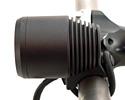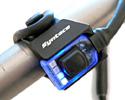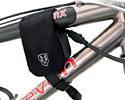
Recently on Cyclingnews.com |
On test: Lupine Edison 5, January 25, 2006
Frying tonight
Part of the challenge of riding at night used to be making your way down the trail in less-than-optimal lighting conditions. The new crop of high-performance lights eliminates the need for compromise and offers near-daylight conditions in a portable package. Lupine's Edison 5 makes a beeline for the king-of-the-night throne and Cyclingnews' James Huang goes stumbling through the darkness to see if it lives up to its lofty aspirations.

|
If you've been night riding for a number of years, you almost certainly have some (not so) fond memories of flying down a trail and relying on more than a little bit of faith. Early off-road Lights weren't very bright, run times weren't very long, and many systems were big and heavy. Back then, a 15W halogen bulb was pretty much par for the course and having two of them, or one of the higher-power dual-beam models, virtually guaranteed you a spot at the cool kid lunch table.
Times have changed. With the growing popularity of the 24 hour race format, lighting technology has developed to meet the demands of pro and amateur racers alike and light outputs have increased accordingly. High-intensity discharge (HID) beams that were once the sole realm of premium automobiles are now virtually commonplace in the mountain bike world, in spite of their correspondingly premium prices. With their increased operating efficiency, typical 10W HID systems (nearly all of which use the same Welch Allyn Solarc bulb and ballast assemblies, by the way) offer light outputs roughly equivalent to a 40W halogen bulb. In addition, their blue-white hue makes them seem even brighter compared to the yellower white of halogens, plus their lower power draw makes for lighter systems with longer burn times. With a bit of portable sunlight at your disposal, night riding has never been safer or faster.
"But these go to eleven!"
|
|
|
|
|
|
|
|
|
|
|
|
|
|
|
For Stefan Kraus at Lupine Lighting Systems in Germany, harnessing a bit of sunlight just wasn't good enough; he wanted a full-blown red giant. Lupine starts with the standard Welch Allyn HID assembly for their Edison 5 system but replaces the stock ballast with a set of proprietary electronics. This custom circuitry allows Lupine to force-feed 16W into the bulb, as compared to the standard 10W. This kicks the light output from the typical 500 lumens to a staggering 900 lumens, or the equivalent of a 65W halogen bulb. Need less light? The advanced electronics package also impart the Edison 5 with the ability to switch to a lower 10W power level, and also provide a reserve tank feature. As further icing on an already tasty cake, you can also program when that reserve tank kicks and can also eliminate the low power setting if so desired.
Lupine's Charger One is another technological powerhouse with an integrated LCD panel which displays the charging voltage and current as well as the charged capacity. As with the lamp head, the charger is also programmable for individual settings and preferences. Adapters for in-house and in-car use are both included with the kit, and the unit is designed to work with all of Lupine's various battery offerings. Speaking of the battery, the Edison 5 is supplied with a high-capacity 6.5Ah Li-Ion pack enclosed in a handy nylon soft case. In spite of the battery's diminutive size (roughly equivalent to two "D" cells stuck together), it still packs enough juice to power the lamp head at full power for a full 3 hours on the high power setting (4.5 hours on the default 10W low power setting). A full charge on this little powerhouse is achieved in just 3 hours. If you need even more run time, the Edison 10 includes a higher capacity water bottle-style battery which buys you a full 6 hours of burn at full power.
Overall construction quality of all of the Edison 5 components is outstanding and durability and weather resistance were clearly priorities in the design. Both the lamp head and charger are extraordinarily compact and are encased in burly, shot peened, anodized aluminum housings. In addition, the lamp head, battery, and connectors are also fully waterproof (and tested in-house under pressure). The entire system, as used, weighs only about 450g, give or take a bit depending on mounting options.
Mmmmm… candlepower
Getting the unit mounted and ready to go is a cinch. Even with all of the customization available, you certainly don't have to use it, and the default settings work just fine. Plug the charger into the wall and the battery into the charger and let the Charger One do its thing. The lamp head can be mounted to either a handlebar or helmet with a surprisingly effective o-ring setup. Standard and oversized diameter handlebars are both easily accommodated, and the lamp head can be rotated a bit to center the beam if needed. The helmet mount is a simple strap-type unit and should work with most helmets regardless of how the vents are distributed.
Out on the trail… wow. That pretty much says it all. I've used a number of high-end lighting systems in the past, but the Edison 5 stands at least a head (or two!) above most other HID setups. Light output on the high setting is noticeably brighter than "standard" 10W systems, and the 18° beam divergence angle is narrow enough to concentrate light effectively yet still offers excellent peripheral lighting even when bar mounted. More importantly, the quality of the beam pattern is outstanding with a nice strong bright spot in the middle and seamless fading out to the periphery with no hot or cold spots. When properly aimed, overrunning your light with the Edison 5 is next to impossible. In spite of the mounting o-ring's minimalist appearance, the lamp head remained stable throughout testing.
Eleven is what you want, but is eleven what you need?
There is little doubt in my mind that the Lupine Edison 5 is one of the highest performance MTB lighting systems currently available. The total light output is simply unbelievable and the beam pattern is faultless. Construction quality is superb and the unit, as a whole, is exceptionally durable and compact. Additionally, advanced programming features provide some features not available on other systems. In short, the Lupine 5's ability to illuminate the trail ahead of you is absolutely unsurpassed.
Ok, so what's the catch? As is the case with most things in this world, those who want the best should also be willing and able to pay for the best. Having said that, the Edison 5 costs a staggering $750USD. Yup, I said $750… for a bike light. If you're looking for maximum value in a HID lighting system, chances are you will likely look elsewhere. However, if only the best will do, the Lupine Edison 5 is it, price be damned.
Price: $750USD
Weight: 450g (lamp head w/integrated handlebar mount and battery)
Pros: Retina-frying light output, perfect beam pattern, light and compact
packaging, advanced lamp and charger circuitry
Cons: High cost associated with being the best. Almost completely removes
the challenges of riding at night. No fair, this is cheating!
More information: www.lupine.de
Cyclingnews rating: ![]()
James Huang is chief guru at mountain bike suspension site www.angryasian.com









